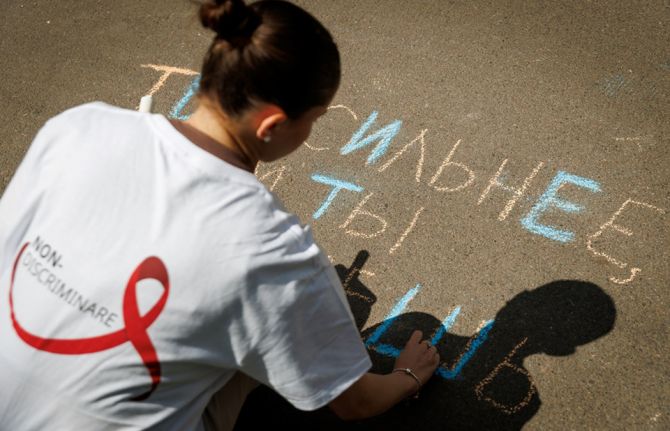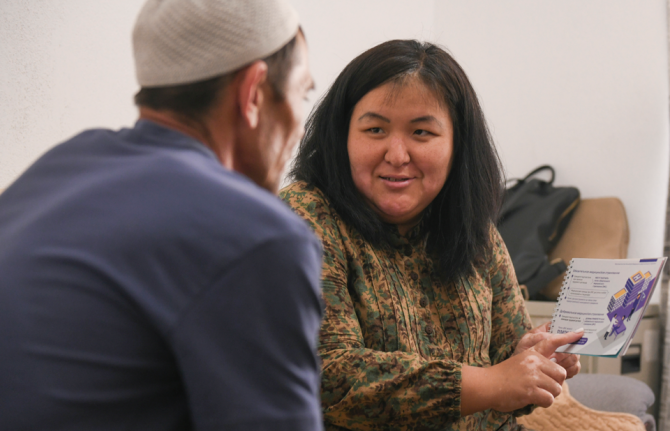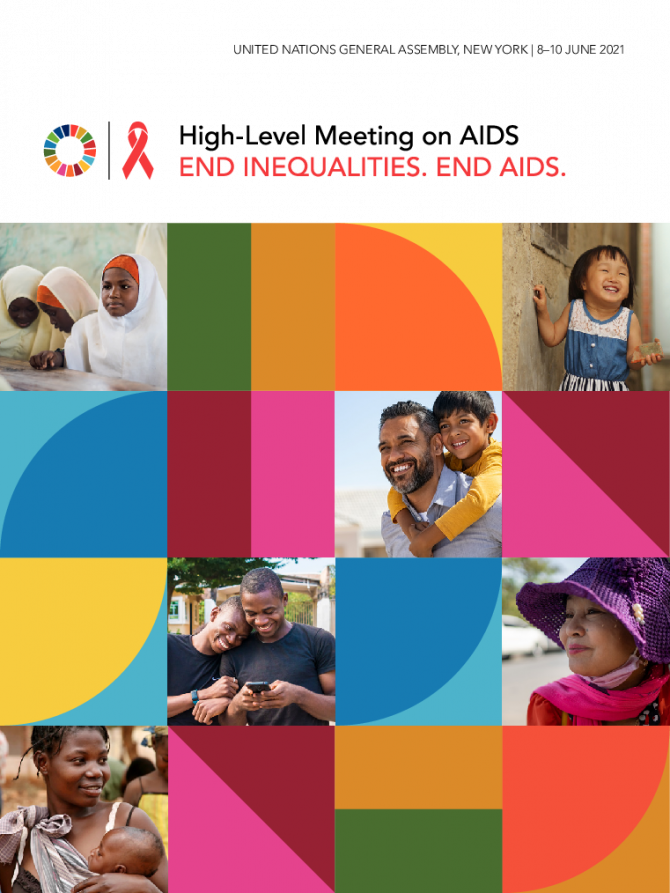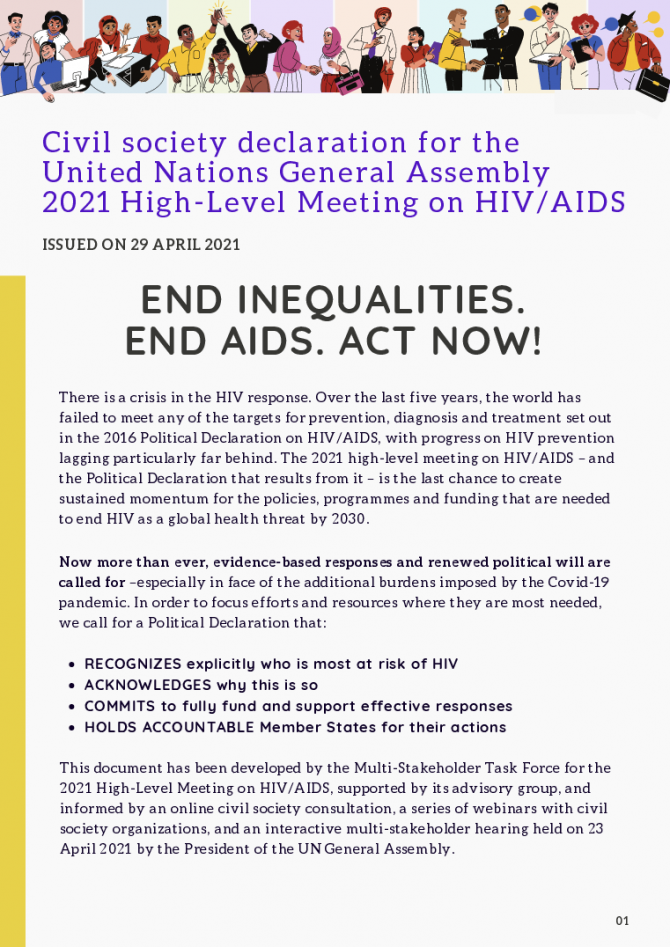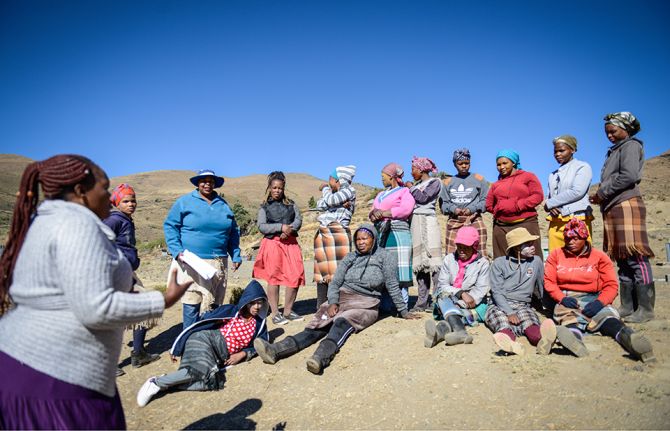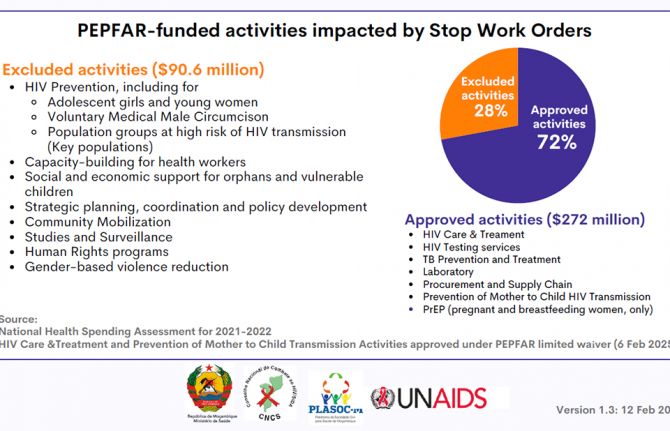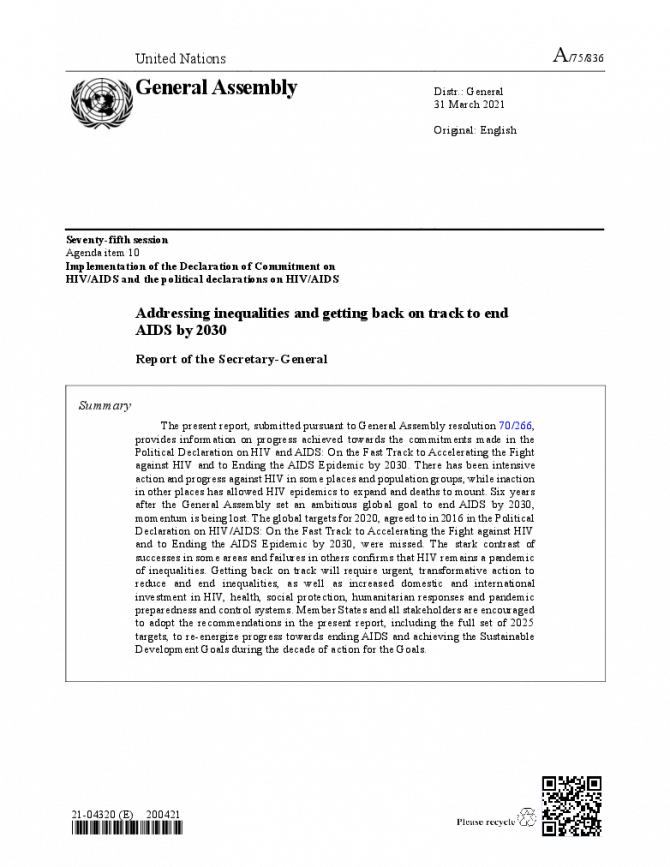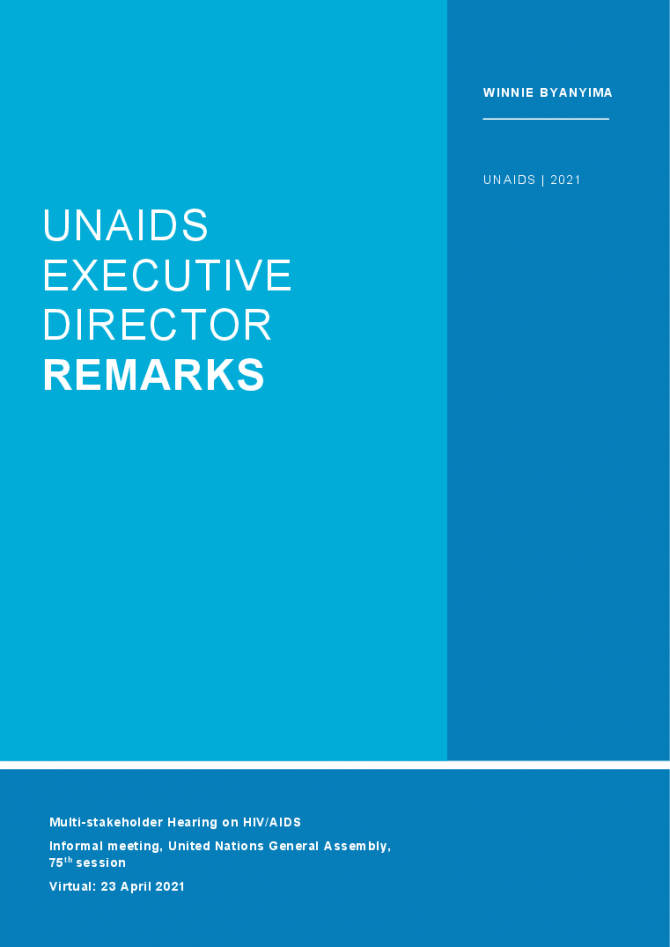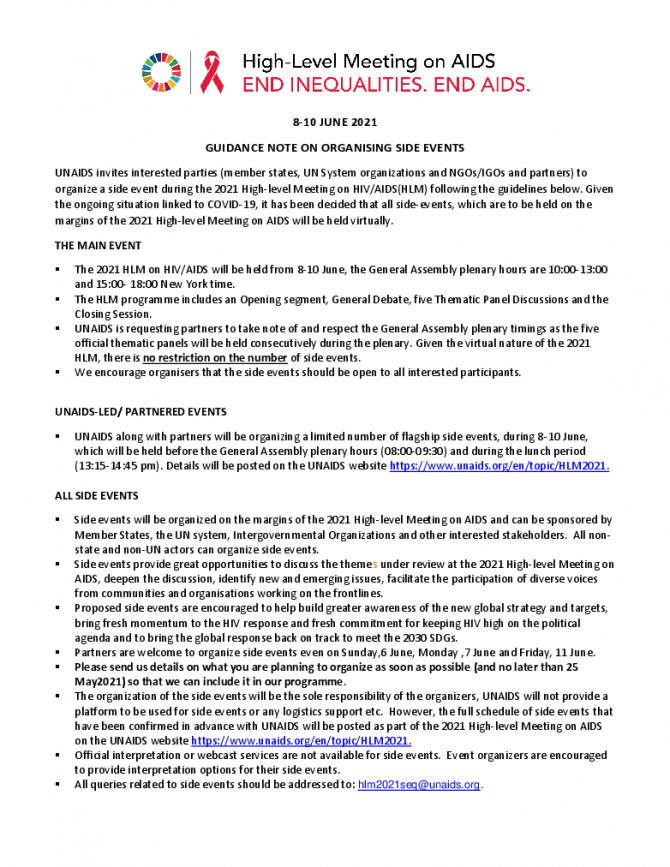
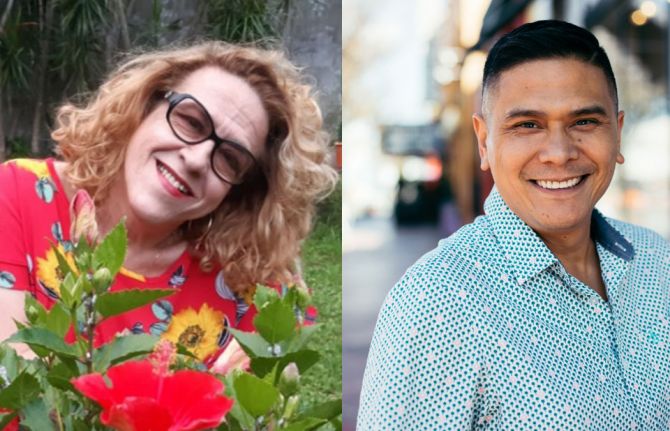
Feature Story
Hearing civil society’s voice on the High-Level Meeting on AIDS
04 June 2021
04 June 2021 04 June 2021At the United Nations High-Level Meeting on AIDS, which will take place from 8 to 10 June, Member States will adopt a new political declaration to bring the HIV response back on track. After the uneven progress made in the HIV response since the 2016 United Nations High-Level Meeting on Ending AIDS, this year’s high-level meeting will be the springboard for a decade of action to reduce inequalities and root out the social determinants that fuel the HIV epidemic.
In order to find out more about civil society’s aspirations and hopes for the high-level meeting and political declaration, UNAIDS talked to two civil society representatives, both of whom are living with HIV. Jacqueline Rocha Côrtes (JRC) is from the National Movement of Women Living with HIV/AIDS (MNCP/Brazil), the Latin American and the Caribbean Movement of Positive Women (MLCM+) and the National Institute of Reassigned Women (INAMUR/Brazil). Andrew Spieldenner (AS) is the Executive Director of Mpact. Both are members of the Multistakeholder Task Force to the HLM and were involved in drafting the 2021 high-level meeting civil society declaration, in which civil society organizations urge Member States to focus efforts and resources where they are most needed and to adopt a political declaration that explicitly recognizes who is most at risk of HIV and acknowledges why this is so, to commit to fully fund and support effective HIV responses and to hold Member States accountable for their actions.
What is the purpose of the civil society declaration you released ahead of the high-level meeting?
JRC: The civil society declaration has several purposes. First of all, to bring together the main inputs given by civil society globally on the desired content of the 2021 political declaration on AIDS. Secondly, the civil society declaration serves as a tool to mobilize community efforts locally and regionally and to harmonize and sharpen our positions in order to build a stronger community position on our demands worldwide.
AS: The civil society declaration released ahead of the high-level meeting is a clear statement of the values, concerns and needs of our communities. Where Member States might be more concerned with politics, civil society continues to elevate and centre those most impacted by HIV—the same populations most often marginalized by governments through punitive laws and policies. As civil society, we want to ensure that Member States understand where we stand, in the hope that they support our work and communities in the development of the political declaration.
What are the major asks from civil society to Member States?
JRC: The major asks from the civil society declaration, from my personal perspective, are to show and remind Member States how strong we are and of our ability to mobilize and guide what is needed to end AIDS. It is an opportunity to show that we, the communities, are alive and attentive, even more so during times like this, where the COVID-19 pandemic has had such a negative impact on the response to AIDS. It is also a call to international and multilateral organizations.
AS: We want Member States to recognize the disproportionate impact of HIV on sex workers, people who use drugs, transgender people and gay and bisexual men and to centre the needs of key populations in the HIV response. We want Member States to support the delivery of necessary HIV interventions, such as comprehensive sexuality education, harm reduction in all its forms and HIV prevention and treatment. We want Member States to protect sexual and reproductive health and rights. We want Member States to be flexible with the Trade-Related Aspects of Intellectual Property Rights (TRIPS) with HIV technologies and to fully fund the HIV response.
What are the expectations of communities and civil society organizations for the upcoming high-level meeting and new political declaration?
JRC: In the political declaration, we expect to see a minimum standard of progressive broad language that includes everyone in order to make it clear that, when we refer to the response to AIDS, we are referring to human rights, the flexibility of trade agreements, the financing of the AIDS response, the community-led responses, the reduction and elimination of gender-based violence. We expect the political declaration to include firm commitments to fulfil the many goals established in the 2016 political declaration and in other political declaration that have not yet been met, as well as the most recent priorities established by the UNAIDS Global AIDS Strategy 2021–2026, agreed by many countries, which calls for the elimination of inequalities to end AIDS by 2030.
We also hope that conveniently politically correct technical language won’t serve as a veil to cover particular interests, leaving aside issues such as sexual and human diversity, sexual health and reproductive rights and the reduction and gradual elimination of punitive laws that further stigmatize people and punish citizens, who are often imprisoned or killed simply because they exist as they are.
AS: As civil society and communities, we expect Member States to support the Global AIDS Strategy 2021–2026. We understand that some Member States will be against the language describing key populations, as well as against key HIV interventions, including harm reduction, comprehensive sexuality education and TRIPS flexibilities. We hope that Member States can seek compromise to embrace and support what’s necessary to move forward in the HIV response.
Some Member States are still reticent to advance the agenda when it comes to key populations, drug use and the criminalization of sex work. What would be your message to them?
JRC: My message to them is that whether they accept it or not, humanity will not be linear like some of their political and economic projects and even social projects that try to dictate the course of human lives, over which the authorities have no governability or rights. In the same way that United Nations Member States refer to national sovereignty on whether to adopt or not certain measures, people have an inalienable autonomy to decide what is best for their lives and how they want to live.
It is imperative that Member States recognize the existence and rights of key populations.
As a reassigned transsexual woman living with HIV for 27 years, I cannot help but state that if we want to end inequalities we will necessarily have to approach and embrace human diversity.
AS: After 40 years of HIV, the disproportionate burden of HIV remains on key populations, including people who use drugs, sex workers, gay and bisexual men and transgender people. We cannot end the HIV epidemic if we do not centre the needs of key populations, including the greater involvement of people living with HIV. If Member States continue to ignore our needs, marginalize our communities and legislate against us, then the HIV epidemic will continue unabated, no matter the advances in HIV technologies.
Once the political declaration has been adopted, what will be the role of civil society in making it a reality on the ground?
JRC: We will do what we have always done—we will advocate and influence politics. We will monitor and mobilize, fight, carry out community-led work and provide community responses, build and act with solidarity, respect the internal dynamics of the various sectors, including the governments, but act on our rights and demand that our governmental authorities to do their work and comply with their commitments and duties.
And we count on UNAIDS, one of our most valuable partners, and on other United Nations agencies.
AS: The global key population networks have been advocates for community-led responses and accountability mechanisms. With the support of multilateral and philanthropic funding, we will continue to support grass-roots local and regional efforts. Unfortunately, with shrinking civil society space and funding, this will be a challenge. We need multilateral and philanthropic support in order to continue this role.
Our work

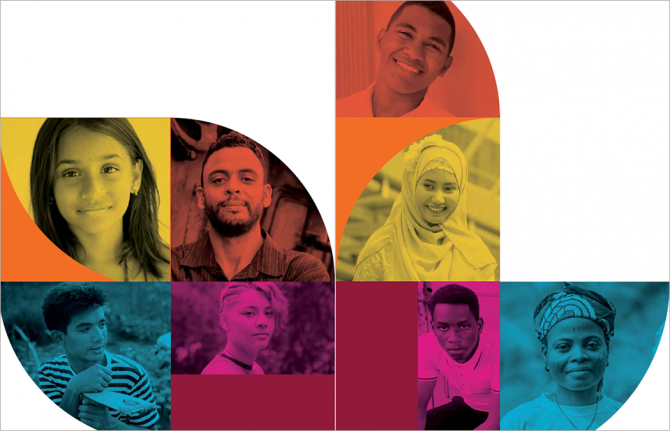
Press Release
Forty years on and new UNAIDS report gives evidence that we can end AIDS
03 June 2021 03 June 2021UNAIDS urges world leaders to adopt a bold political declaration on HIV at the United Nations General Assembly High-Level Meeting on AIDS, being held in New York and online next week, and to commit to achieving a new set of targets for 2025 to end AIDS by 2030
NEW YORK/GENEVA, 3 June 2021—Four decades after the first cases of AIDS were reported, new data from UNAIDS show that dozens of countries achieved or exceed the 2020 targets set by the United Nations General Assembly in 2016—evidence that the targets were not just aspirational but achievable.
The report shows that countries with progressive laws and policies and strong and inclusive health systems have had the best outcomes against HIV. In those countries, people living with and affected by HIV are more likely to have access to effective HIV services, including HIV testing, pre-exposure prophylaxis (medicine to prevent HIV), harm reduction, multimonth supplies of HIV treatment and consistent, quality follow-up and care.
“High-performing countries have provided paths for others to follow,” said Winnie Byanyima, the Executive Director of UNAIDS. “Their adequate funding, genuine community engagement, rights-based and multisectoral approaches and the use of scientific evidence to guide focused strategies have reversed their epidemics and saved lives. These elements are invaluable for pandemic preparedness and responses against HIV, COVID-19 and many other diseases.”
Globally, the report shows that the number of people on treatment has more than tripled since 2010. In 2020, 27.4 million of the 37.6 million people living with HIV were on treatment, up from just 7.8 million in 2010. The roll-out of affordable, quality treatment is estimated to have averted 16.2 million deaths since 2001.
Deaths have fallen in large part due to the roll-out of antiretroviral therapy. AIDS-related deaths have fallen by 43% since 2010, to 690 000 in 2020. Progress in reducing new HIV infections has also been made, but has been markedly slower—a 30% reduction since 2010, with 1.5 million people newly infected with the virus in 2020 compared to 2.1 million in 2010.
The report underscores that countries with punitive laws and that do not take a rights-based approach to health punish, ignore, stigmatize and leave key populations—which make up 62% of new HIV infections worldwide—on the margins and out of reach of HIV services. For example, almost 70 countries worldwide criminalize same-sex sexual relationships. Gay men and other men who have sex with men, sex workers, transgender people, people in prison and people who inject drugs are left with little or no access to health or social services, allowing HIV to spread among the most vulnerable in society.
Young women in sub-Saharan Africa also continue to be left behind. Six out of seven new HIV infections among adolescents aged 15–19 years in the region are among girls. AIDS-related illnesses remain the leading cause of death among women aged 15–49 years in sub-Saharan Africa.
COVID-19 has shown the fragility of the health and development gains made over the past decades and has exposed glaring inequalities. To get the world on track to end AIDS by 2030, the global AIDS community and UNAIDS have used an inequalities lens to develop an ambitious and achievable strategy with new targets to reach by 2025. Ending inequalities requires HIV responses that can reach the populations currently being left behind.
If reached, the targets will bring HIV services to 95% of the people who need them, reduce annual HIV infections to fewer than 370 000 and AIDS-related deaths to fewer than 250 000 by 2025. This will require an investment of US$ 29 billion a year by 2025. Each additional US$ 1 of investment in implementing the global AIDS strategy will bring a return of more than US$ 7 in health benefits.
UNAIDS urges the United Nations General Assembly to commit to the targets in a new political declaration on HIV at the fifth United Nations General Assembly High-Level Meeting on AIDS, taking place from 8 to 10 June 2021.
“The world cannot afford to underinvest in pandemic preparedness and responses,” said Ms Byanyima. “I strongly urge the United Nations General Assembly to seize the moment and commit to taking the actions needed to end AIDS.”
UNAIDS
The Joint United Nations Programme on HIV/AIDS (UNAIDS) leads and inspires the world to achieve its shared vision of zero new HIV infections, zero discrimination and zero AIDS-related deaths. UNAIDS unites the efforts of 11 UN organizations—UNHCR, UNICEF, WFP, UNDP, UNFPA, UNODC, UN Women, ILO, UNESCO, WHO and the World Bank—and works closely with global and national partners towards ending the AIDS epidemic by 2030 as part of the Sustainable Development Goals. Learn more at unaids.org and connect with us on Facebook, Twitter, Instagram and YouTube.
Watch
Documents
Brochure - High-level meeting on AIDS, 8-10 June 2021
12 April 2021
The 2021 high-level meeting will be the springboard for a decade of action to reduce inequalities and root out the social determinants that fuel the HIV epidemic. Learn more about HLM 2021
Documents
Civil society declaration for the United Nations General Assembly 2021 High-Level Meeting on HIV/AIDS
04 May 2021
This document has been developed by the Multi-Stakeholder Task Force for the 2021 High-Level Meeting on HIV/AIDS, supported by its advisory group, and informed by an online civil society consultation, a series of webinars with civil society organizations, and an interactive multi-stakeholder hearing held on 23 April 2021 by the President of the UN General Assembly.

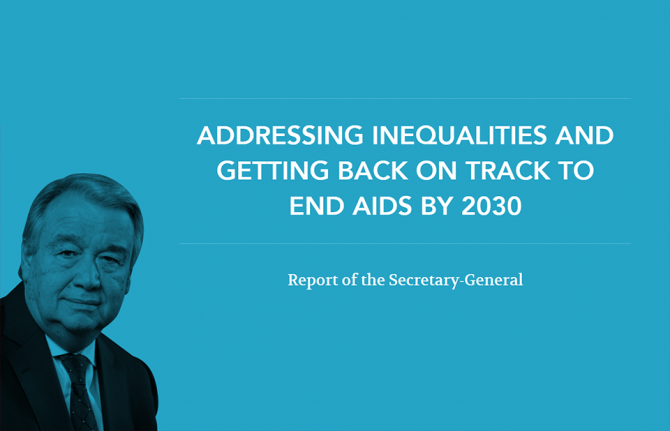
Press Release
United Nations Secretary-General calls for a greater focus on ending inequalities to end AIDS
30 April 2021 30 April 2021Forty years since the first AIDS cases were reported and just weeks before the United Nations General Assembly High-Level Meeting on AIDS, the United Nations Secretary-General has released a new report with recommendations and targets to get the world back on track to end AIDS
NEW YORK, 30 April 2021—The United Nations Secretary-General, António Guterres, has warned that despite intensive action and progress made against HIV in some places and population groups, HIV epidemics continue to expand in others and issued a set of 10 key recommendations.* If followed by all countries, this will end the AIDS pandemic as a public health threat by 2030 as part of the Sustainable Development Goals. In a new report, Addressing inequalities and getting back on track to end AIDS by 2030, the United Nations Secretary-General urges the world to address the inequalities that are slowing progress.
“It is imperative to break out of an increasingly costly and unsustainable cycle of achieving some progress against HIV but ultimately not enough to bring about an end to the pandemic,” said Mr Guterres in the report. “Inequalities are the key reason why the 2020 global targets were missed. By ending inequalities, transformative outcomes can be achieved for people living with HIV, communities and countries.”
The global targets set out in the General Assembly’s 2016 Political Declaration on Ending AIDS were missed by a long way, allowing the AIDS pandemic to grow in many regions and countries. The staggering 1.7 million new HIV infections that occurred in 2019 are more than three times higher than the 2020 target of less than 500 000 new infections. In addition, the 690 000 AIDS-related deaths in 2019 far exceed the 2020 target of reducing deaths to fewer than 500 000 a year.
“Ending AIDS as a public health threat by 2030 is still within reach—many countries are showing that rapid progress against HIV is possible when evidence-informed strategies and human rights-based approaches are adopted,” said UNAIDS Executive Director Winnie Byanyima. “But it requires bold political leadership to challenge and address the social injustices and inequalities that continue to make certain groups of people and entire communities highly vulnerable to HIV infection.”
The report notes that COVID-19 has caused additional setbacks. The United Nations Secretary-General warned that COVID-19 is not an excuse for missing AIDS targets, but rather a stark warning to the countries that they can no longer afford to underinvest in pandemic preparedness and responses.
At the same time, the COVID-19 pandemic has underscored the many spill-over benefits of HIV investments in health and development. Community-led service delivery pioneered by the HIV response is helping to overcome the extraordinary impediments created by COVID-19.
The set of 10 recommendations to get the world back on track include: addressing inequalities and reaching all people living with or at risk of HIV infection to reduce the annual new HIV infections to under 370 000 and annual AIDS-related deaths to under 250 000 by 2025; prioritizing HIV prevention to ensure that 95% of people at risk of HIV infection have access to effective HIV prevention options by 2025; and eliminating new HIV infections among children.
The report underscores that addressing social and structural factors that perpetuate inequalities is key. It highlights, for example, how gender inequality, underpinned by harmful gender norms, restricts women’s use of HIV and sexual and reproductive health services by perpetuating gender-based violence and limiting decision-making power, including the ability of women and girls to refuse unwanted sex, negotiate safer sex and mitigate HIV risk.
It also shows how vulnerable, marginalized and criminalized communities, such as gay men and other men who have sex with men, people who use drugs, sex workers, transgender people, prisoners and migrants, also remain at higher risk of HIV infection than the general population because they are not receiving essential information and HIV treatment, prevention and care services.
The United Nations Secretary-General describes how communities of people living with, at risk of and affected by HIV are the backbone of the HIV response. Initiatives led by people living with HIV, women, key populations, young people and other affected communities have identified and addressed key inequalities and service gaps, advocated for the rights of their constituents and expanded the reach, scale and quality of health services.
In the report, Mr Guterres applauds UNAIDS’ recently adopted Global AIDS Strategy 2021–2026: End Inequalities, End AIDS. “The lessons from the countries, cities and communities that successfully fast-tracked their HIV responses over the last five years are at the heart of the UNAIDS Global AIDS Strategy 2021–2026,” said Mr Guterres. “The global AIDS community and UNAIDS have used an inequalities lens to develop the strategy, with new targets that are ambitious, granular and tailored to reach the furthest behind first.”
The report comes 25 years after the creation of UNAIDS and describes how COVID-19 has exposed social inequalities and health system weaknesses. The United Nations Secretary-General says that the world should leverage the experience from responding to the AIDS pandemic to strengthen health systems across the world and improve pandemic preparedness. He also calls for enhanced global solidarity to close the HIV resource gap and increase annual HIV investments in low- and middle-income countries to US$ 29 billion by 2025.
*The 10 recommendations in the United Nations Secretary-General’s report:
- Reduce and end the acute and intersecting inequalities that are obstructing progress to end AIDS.
- Prioritize HIV prevention and ensure that 95% of people at risk of HIV infection have access to and use appropriate, prioritized, person-centred and effective combination prevention options by 2025.
- Close gaps in HIV testing, treatment and viral suppression that are limiting the impact of HIV responses and achieve by 2025 the 95–95–95 testing and treatment targets within all subpopulations, age groups and geographic settings, including children living with HIV.
- Eliminate vertical HIV transmission and end paediatric AIDS.
- Put gender equality and the human rights of women and girls in all their diversity at the forefront of efforts to mitigate the risk and impact of HIV.
- Implement the GIPA (Greater Involvement of People Living with HIV/AIDS) principle and empower communities of people living with HIV, women, adolescents and young people and key populations to play their critical HIV response roles.
- Respect, protect and fulfil the human rights of people living with, at risk of and affected by HIV and ensure by 2025 that less than 10% of people living with HIV and key populations experience stigma and discrimination.
- Enhance global solidarity to close the HIV response resource gap and increase annual HIV investments in low- and middle-income countries to US$29 billion by 2025.
- Accelerate progress towards universal health coverage and strong primary health care systems, build forward better and fairer from COVID-19 and humanitarian crises, and strengthen global health security and future pandemic preparedness.
- Leverage the 25 years of experience, expertise and mandate of the Joint United Nations Programme on HIV/AIDS (UNAIDS) in building multisectoral, multi-stakeholder and rights-based collaborative action to end AIDS and deliver health for all as global public good.
UNAIDS
The Joint United Nations Programme on HIV/AIDS (UNAIDS) leads and inspires the world to achieve its shared vision of zero new HIV infections, zero discrimination and zero AIDS-related deaths. UNAIDS unites the efforts of 11 UN organizations—UNHCR, UNICEF, WFP, UNDP, UNFPA, UNODC, UN Women, ILO, UNESCO, WHO and the World Bank—and works closely with global and national partners towards ending the AIDS epidemic by 2030 as part of the Sustainable Development Goals. Learn more at unaids.org and connect with us on Facebook, Twitter, Instagram and YouTube.
Contact
UNAIDS GenevaSophie Barton-Knott
tel. +41 79 514 6896
bartonknotts@unaids.org
UNAIDS Geneva
Michael Hollingdale
tel. +41 79 500 2119
hollingdalem@unaids.org
Press centre
Download the printable version (PDF)

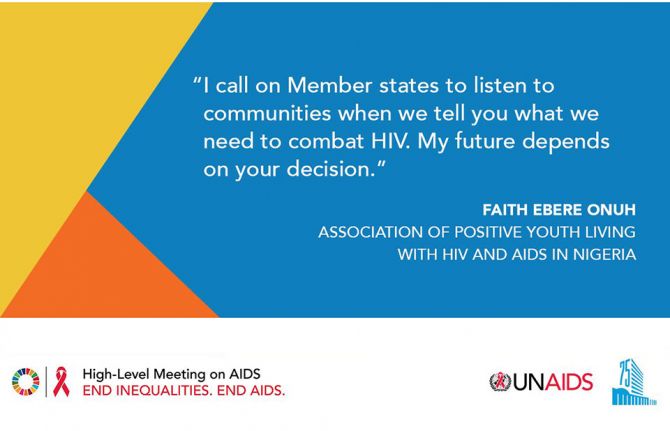
Feature Story
Interactive multistakeholder hearing takes place ahead of United Nations High-Level Meeting on AIDS
26 April 2021
26 April 2021 26 April 2021Representatives of all stakeholders in the AIDS response came together virtually on 23 April for the interactive multistakeholder hearing ahead of June’s United Nations High-Level Meeting on AIDS.
Those taking part included people living with, at risk of and affected by HIV, representatives of Member States, parliamentarians, and representatives of local governments, civil society organizations, philanthropic foundations, academia, medical associations, the private sector, and broader communities. The objective of the meeting was to support Member States with the preparations for the high-level meeting through an interactive dialogue with communities, civil society and other key stakeholders.
In his opening remarks, the President of the General Assembly, Volkan Bozkir, applauded activists for their work in reducing the impact of the HIV epidemic.
“Your participation here today is not taken for granted. I understand that many of you began advocating and organizing after experiencing loss, suffering, discrimination, and marginalization. I commend you for sharing your lived experience in order to create a better world for all. Your resilience is unmatched.”
In her address to the meeting, the Executive Director of UNAIDS, Winnie Byanyima, said that it was the loud and persistent voice of people living with HIV and the communities most affected by the epidemic that had accelerated progress against the virus. Ms. Byanyima also underlined that the HIV response was closely linked to social justice issues.
“The struggle to end AIDS is inextricably linked with the struggle to end human rights violations, including discrimination and violence against women and girls and the marginalization and criminalization of people living with HIV and of key populations—sex workers, people who use drugs, gay, bisexual and other men who have sex with men, and transgender people.”
Faith Ebere Onuh is a young woman who was born with HIV and a member of the Association of Positive Youth Living with HIV and AIDS in Nigeria (APYIN). When she was 14 years old Ms Ebere Onuh started educating other young people living with HIV about the importance of adhering to their HIV medication. She has become a mentor and a voice for the voiceless, speaking up for young people in Nigeria.
“As a young person, I have learned in my time living with HIV and working with my community that to reach the target of ending AIDS by 2030, we must work together, as a global community. While as various individual member states we may be making progress, globally we are still off track, and some regions like mine, West and Central Africa, continue to lag behind.”
Neville Gertze, Permanent Representative of Namibia to the United Nations and co-facilitator for the preparations for the 2021 High-Level Meeting on AIDS, said lessons learned in responding to HIV and COVID-19 could be leveraged to improve health systems.
“By taking on board lessons learned through HIV, fighting COVID-19 can aid in reimagining systems of health to accelerate the health-related commitments of the 2030 Agenda for Sustainable Development. At the same time the HIV experience helps to inform COVID-19 responses, the unfolding response to the COVID-19 pandemic will undoubtedly yield lessons that can benefit both the HIV response as well as broader efforts to strengthen health systems.”
There were four panels during the day to consider the following areas of the HIV response.
1. Equitable and equal access to HIV prevention, treatment and services.
2. Structural and social barriers to achieving HIV outcomes (zero new HIV infections, zero discrimination and zero AIDS-related deaths).
3. How to fully resource and sustain efficient HIV responses and integrate them into systems for health, development, social protection, humanitarian settings and pandemic responses.
4. Bringing it together: building synergies and addressing critical gaps.
A summary report of the interactive multistakeholder hearing will be available on the President of the General Assembly website prior to the United Nations High-Level Meeting on AIDS, which takes place from 8 to 10 June 2021.
Documents
Report of the UN Secretary-General on the Implementation of the Declaration of Commitment on HIV/AIDS and the political declarations on HIV/AIDS (Seventy-fifth session of the General Assembly) 31 March 2021 - A/75/836
31 March 2021
The present report, submitted pursuant to General Assembly resolution 70/266, provides information on progress achieved towards the commitments made in the Political Declaration on HIV and AIDS: On the Fast Track to Accelerating the Fight against HIV and to Ending the AIDS Epidemic by 2030. This document is also available in Arabic and Chinese.
Documents
Guidance note on organising side events — 2021 High-level meeting on HIV/AIDS
22 April 2021
UNAIDS invites interested parties (member states, UN System organizations and NGOs/IGOs and partners) to organize a side event during the 2021 High-level Meeting on HIV/AIDS (HLM) following the guidelines below. Given the ongoing situation linked to COVID-19, it has been decided that all side-events, which are to be held on the margins of the 2021 High-level Meeting on AIDS will be held virtually.

